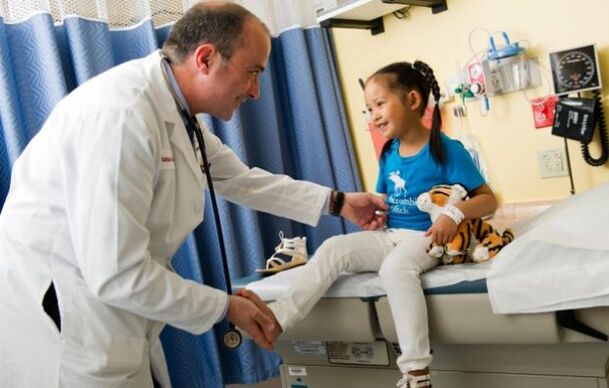Osteoarthritis of the hip joint is a progressive and chronic disease of the musculoskeletal system. Dystrophic changes begin in the cartilage tissue, its structure changes, loosens, becomes fibrous, becomes thinner and loses its amortization function. As a result, the bone joints begin to rub against each other, motor activity is lost, and pain occurs. When left untreated, a person becomes disabled.
Clinical picture and causes of osteoarthritis
Osteoarthritis of the hip joint is the leading disease of the musculoskeletal system and mainly affects the adult population after the age of 35. In the medical classification, he was assigned the code M16 in accordance with MBK 10.
The hip joint is the largest of the human body and carries the greatest load. It connects the bones to the pelvis and has a spherical shape. The round head of the femur is inserted into the acetabular notch. Its surface is covered with cartilage tissue, which allows the bones to slide and perform shock absorption functions, protecting the bones from friction and destruction, and providing a wide range of motion.
The mechanism of osteoarthritis is simple:
- The amount of synovial fluid decreases, so the joint is washed worse with it, and the supply of nutrients is reduced.
- The structure of the joint is emptied. Due to friction, the cartilage becomes thinner, stopping the pressure on the bones.
- Growths (osteophytes) form along the edges of the bone.
- The joint space gradually decreases.
- The person experiences severe pain, movement problems, limb shortening, and lameness.
Hip arthrosis can develop for several reasons, but more often it is triggered by a combination of adverse events. The disease is divided into primary and secondary. In the first case, doctors do not find a reason for the development of the disease, and secondly, osteoarthritis occurs due to certain pathologies.

The main reasons:
- trauma;
- power loads, especially in the post-traumatic period, when the joint has not yet been restored;
- overweight;
- congenital anomalies of the femoral head (dysplasia);
- heredity;
- arthritis (inflammation of the joints);
- long-term stress;
- hormonal changes and diseases of the endocrine system;
- infectious diseases.

Osteoarthritis can be unilateral, with damage to the right or left hip joint. More often, when the pathological process affects both parties, there is a two-sided choice.
Symptoms and degrees of osteoarthritis
The clinic of osteoarthritis directly depends on the stage of the disease. At first, a person begins to feel a slight discomfort in the groin and stiffness of the foot in the morning, the soft tissues do not swell and swell. As the pathology progresses, an acute period characterized by severe pain begins.
Note. When the first symptoms appear, you should consult a doctor and undergo an examination. Early disease responds well to treatment.
The main complaint of all patients is pain and limited mobility. Their severity depends on the dystrophic changes in the cartilage.
There are 3 degrees of the disease:
- In grade 1, anxiety occurs only after prolonged physical exertion (climbing, running, cycling) that goes away on its own after rest. Muscles are in good condition, movements are not limited. X-rays may show a narrowing of the joint space.
- Grade 2 pain begins, is applied to the groin area, and spreads to the front of the hips and thighs. When trying to get up or start walking, there are "initial" pains that disappear after 2-3 minutes. After a long period of tension, the pain increases and disappears at rest. One symptom of osteoarthritis is a characteristic crisis in the joint, limited movement (hip abduction), decreased muscle strength, painful sensations, spasm of smooth muscles. X-rays show small osteophytes along the edges of the bony areas of the joints. The femoral neck thickens and expands, the joint space narrows significantly.
- In grade 3, the pain is persistent and does not decrease even at rest. While walking, patients use improvised objects (cane, armpit). There is atrophy of the muscle tissue of the thigh and lower leg, the limb is shortened - the patient is forced to stand on tiptoes to reach the ground. The X-ray shows massive osteophytes, the femoral head is flattened, and the joint space is virtually invisible.
Some doctors also distinguish the 4th degree of the disease. Osteoporosis and complete disability occur, a person can not move without the help of the armpits. The degree of osteoarthritis is based on X-rays, which help to clarify the etiology of the pathological process.
The following types of osteoarthritis are distinguished:
- dysplastic - the slope of the acetabulum is determined;
- posttraumatic - depends on the nature of the injury and the shape of the joint after bone fusion.
Pediatric osteoarthritis
Causes of pathology in children are trauma, subluxation and dysplasia. Metabolic disorders can lead to the destruction of cartilage tissue.
The main symptom of the disease in children is pain syndrome after long games. As osteoarthritis develops, they become denser and stronger. The child refuses to run, loses appetite, excessive tears appear. The second symptom, limited movement in the affected joint, is numbness of the foot. Parents should pay attention to the characteristic crisis. If the first symptoms appear, consult a doctor immediately.
Note. The child's body recovers faster than an adult. Timely treatment will save the child from disability.
If the diagnosis is confirmed, the main goal is to improve the blood supply to the joint. For this, the doctor prescribes various physiotherapy procedures, exercise therapy, visits to sanatoriums, medications.

Prevention consists of proper nutrition. B, C, D vitamins are especially important. You need to walk a lot in the fresh air, be active and avoid traumatic situations.
The difference between osteoarthritis and other joint diseases
Many patients who hear the diagnosis of "arthrosis" confuse it with other diseases of the joints. Doctors often refer to "coxarthrosis" in medical history. Consonant words confuse the patient.
Osteoarthritis is a general name for the pathological processes that lead to the destruction of cartilage tissue. It usually disappears with joint deformation without infectious and inflammatory processes. May affect knees, elbows, shoulders and other joints. Coxarthrosis is osteoarthritis of the hip joint, as indicated by the prefix "cox", which emphasizes a specific area.
What is the difference between sacroilitis and osteoarthritis? In the first case, inflammation of the sacroiliac joint occurs, which is characterized by pain in the sacrum while sitting. There is swelling in the vertebrae, pain in the hips. With osteoarthritis, the cartilage becomes thinner, which leads to friction of the bones - which causes pain.
Arthritis is an inflammatory process in the joint tissue. The difference with osteoarthritis is that the latter is caused by mechanical movements that cause cartilage erosion. Arthritis causes swelling and redness in the articular region, caused by infectious diseases or inflammatory processes in the body. The reactive phase of the disease almost always causes osteoarthritis. The pain is similar, but decreases at night with coxarthrosis and is exacerbated by arthritis.
The clinical picture is similar. Doctors perform blood samples and tests to correctly diagnose and rule out arthritis and sacroiliitis. The increased content of leukocytes and ESR indicates an inflammatory process in the body.
Diet
Osteoarthritis requires long-term and comprehensive treatment based on medication, physiotherapy, exercise therapy and massage, and diet plays an important role. Proper nutrition is needed both in the exacerbation phase and in the remission phase. It should be balanced and contain all the essential vitamins. In addition, the diet helps to lose weight, which reduces stress on the joints.
Allowed products:
- vegetables and fruits;
- lean meat;
- porridge crushed on water;
- dairy products;
- bran bread;
- fish;
- bal;
- mushrooms;
- nuts.
The menu should include gelatin. On its basis you can prepare various desserts from berries and fruits, as well as jelly meat. Eat cottage cheese, yogurt, milk every day. It is better to replace chicken eggs with quail eggs. Boil, simmer or steam the food. Remove fried and fatty foods. Prefer vegetable oils. Drink at least 1, 5 liters of clean water a day. The temperature of the food should not be too high or too low.

Avoid fast snacks with sweet soda. Exclude semi-finished products, sausages, canned food. Prefer natural products without additional preservatives.
What is forbidden:
- acids;
- smoked products;
- white bread and bakery products;
- hot spices;
- garlic;
- radish;
- fatty meat;
- Salo;
- Canned food;
- mayonnaise;
- dairy products with high fat content;
- carbonated drinks;
- alcohol.
Important. Food intake should be 200 grams, often, at least 5-6 times a day. Snacks are made with your favorite fruits, you can drink a glass of kefir at night. The diet should not exceed 2000 kcal for women and 3000 kcal for men.

Prophylaxis
Preventive measures include timely elimination of the root causes of the disease and general strengthening measures.
To prevent the development of the disease, you must follow the following rules:
- Lead an active lifestyle. Swimming is recommended to train without stress on the joints. Preventive measures include baths and saunas that improve blood flow and remove toxins.
- Follow a diet. It is necessary to provide the body with the necessary vitamins and speed up metabolic processes.
- Avoid hypothermia. Low temperatures cause muscle cramps, which disrupt the blood supply to the joint.
- Minimize the likelihood of trauma, especially with the development of coxarthrosis.
According to the rules, the feedback from patients was positive. They noted that pain was reduced, joint mobility was restored, and well-being improved.

Coxarthrosis or hip arthrosis is a chronic disease with exacerbations and remissions. Timely treatment allows to stop the dystrophic process in the cartilage tissue and maintain the mobility of the legs. In the absence of therapy, a person becomes disabled, and in this case, only surgery and joint replacement can restore the musculoskeletal system.

























